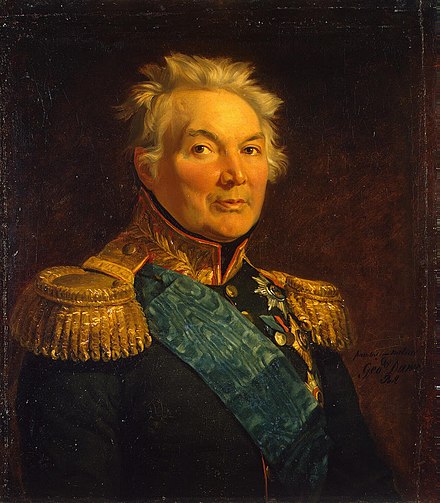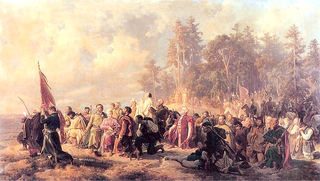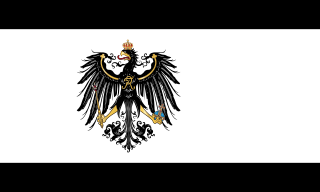
The Battle of Brienne saw an Imperial French army led by Emperor Napoleon attack Prussian and Russian forces commanded by Prussian Field Marshal Gebhard Leberecht von Blücher. After heavy fighting that went on into the night, the French seized the château, nearly capturing Blücher. However, the French were unable to dislodge the Russians from the town of Brienne-le-Château. Napoleon himself, making his first appearance on a battlefield in 1814, was also nearly captured. Very early the next morning, Blücher's troops quietly abandoned the town and retreated to the south, conceding the field to the French.

The Battle of Champaubert was the opening engagement of the Six Days' Campaign. It was fought between a French army led by Napoleon and a small Russian corps commanded by Lieutenant General Count Zakhar Dmitrievich Olsufiev. After putting up a good fight, the Russian formation was effectively destroyed; the survivors escaped into the woods while Olsufiev became a French prisoner. Champaubert is located in France, 46 kilometres (29 mi) west of Châlons-en-Champagne and 69 kilometres (43 mi) east of Meaux.

The Battle of Craonne was a battle between an Imperial French army under Emperor Napoleon I opposing a combined army of Imperial Russians and Prussians led by Prussian Field Marshal Gebhard Leberecht von Blücher. The War of the Sixth Coalition engagement began when the bulk of Napoleon's army tried to drive Mikhail Semyonovich Vorontsov's 22,000 Russians off the Chemin des Dames plateau to the west of Craonne. After a bitter struggle, Napoleon's attacks compelled Vorontsov's force to withdraw, but French casualties exceeded Russian losses. While the battle raged, Blücher's attempt to turn Napoleon's east flank ended in failure due to poor planning.

The Battle of Montmirail was fought between a French force led by Emperor Napoleon and two Allied corps commanded by Fabian Wilhelm von Osten-Sacken and Ludwig Yorck von Wartenburg. In hard fighting that lasted until evening, French troops including the Imperial Guard defeated Sacken's Russian soldiers and compelled them to retreat to the north. Part of Yorck's Prussian I Corps tried to intervene in the struggle but it was also driven off. The battle occurred near Montmirail, France during the Six Days Campaign of the Napoleonic Wars. Montmirail is located 51 kilometres (32 mi) east of Meaux.

The Battle of Mormant was fought during the War of the Sixth Coalition between an Imperial French army under Emperor Napoleon I and a division of Russians under Count Peter Petrovich Pahlen. Enveloped by cavalry led by François Étienne de Kellermann and Édouard Jean-Baptiste Milhaud and infantry led by Étienne Maurice Gérard, Pahlen's outnumbered force was nearly destroyed, with only about a third of its soldiers escaping. Later in the day, a French column led by Marshal Claude Perrin Victor encountered an Austrian-Bavarian rearguard under Anton Leonhard von Hardegg and Peter de Lamotte in the Battle of Valjouan. Attacked by French infantry and cavalry, the Allied force was mauled before it withdrew behind the Seine River. The Mormant-Valjouan actions and the Battle of Montereau the following day marked the start of a French counteroffensive intended to drive back Karl Philipp, Prince of Schwarzenberg's Allied Army of Bohemia. The town of Mormant is located 50 kilometres (31 mi) southeast of Paris.
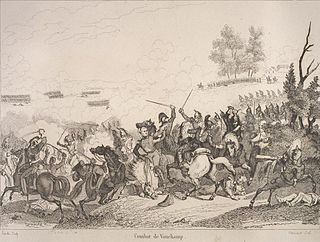
The Battle of Vauchamps was the final major engagement of the Six Days Campaign of the War of the Sixth Coalition. It resulted in a part of the Grande Armée under Napoleon I defeating a superior Prussian and Russian force of the Army of Silesia under Field-marshal Gebhard Leberecht von Blücher.

Prince Michael Andreas Barclay de Tolly was a Baltic German Field Marshal and Minister of War of the Russian Empire during Napoleon's invasion in 1812 and War of the Sixth Coalition. Barclay implemented a number of reforms during this time that improved supply system in the army, doubled the number of army troops, and implemented new combat training principles. He was also the Governor-General of Finland.

Johann David Ludwig Graf Yorck von Wartenburg was a Prussian Generalfeldmarschall instrumental in the switching of the Kingdom of Prussia from a French alliance to a Russian alliance during the War of the Sixth Coalition. Ludwig van Beethoven's "Yorckscher Marsch" is named in his honor.
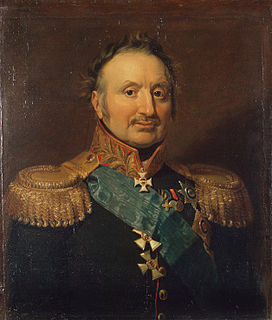
Louis Adolph Peter, 1st Prince of Sayn-Wittgenstein-Ludwigsburg-Berleburg, better known as Peter Wittgenstein in English, was a Prince of the German dynasty Sayn-Wittgenstein and Field Marshal in the Imperial Russian Army during the Napoleonic wars.

The Battle of Château-Thierry saw the Imperial French army commanded by Emperor Napoleon attempt to destroy a Prussian corps led by Ludwig Yorck von Wartenburg and an Imperial Russian corps under Fabian Wilhelm von Osten-Sacken. The two Allied corps managed to escape across the Marne River, but suffered considerably heavier losses than the pursuing French. This action occurred during the Six Days' Campaign, a series of victories that Napoleon won over Prussian Field Marshal Gebhard Leberecht von Blücher's Army of Silesia. Château-Thierry lies about 75 kilometres (47 mi) northeast of Paris.

The Battle of Fère-Champenoise was fought between two Imperial French corps led by Marshals Auguste de Marmont and Édouard Mortier, duc de Trévise and a larger Coalition force composed of cavalry from the Austrian Empire, Kingdom of Prussia, Kingdom of Württemberg, and Russian Empire. Caught by surprise by Field Marshal Karl Philipp, Prince of Schwarzenberg's main Coalition army, the forces under Marmont and Mortier were steadily driven back and finally completely routed by aggressive Allied horsemen and gunners, suffering heavy casualties and the loss of most of their artillery. Two divisions of French National Guards under Michel-Marie Pacthod escorting a nearby convoy were also attacked and wiped out in the Battle of Bannes. The battleground was near the town Fère-Champenoise located 40 kilometres (25 mi) southwest of Châlons-en-Champagne.
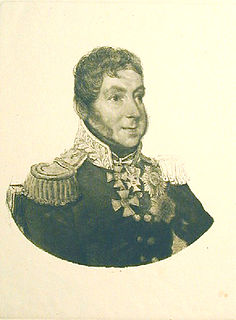
Prince Aleksey Ivanovich Gorchakov was a Russian general and statesman from the Gorchakov family.

Alexander Mikhailovich Rimsky-Korsakov was a Russian general remembered as an unlucky assistant to Alexander Suvorov during his Swiss expedition of 1799–1800.
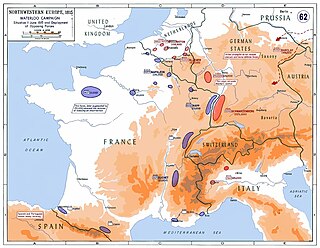
On 1 March 1815 Napoleon Bonaparte escaped from his imprisonment on the isle of Elba, and launched a bid to recover his empire. A confederation of European powers pledged to stop him. During the period known as the Hundred Days Napoleon chose to confront the armies of Prince Blücher and the Duke of Wellington in what has become known as the Waterloo Campaign. He was decisively defeated by the two allied armies at the Battle of Waterloo, which then marched on Paris forcing Napoleon to abdicate for the second time. However Russia, Austria and some of the minor German states also fielded armies against him and all of them also invaded France. Of these other armies the ones engaged in the largest campaigns and saw the most fighting were two Austrian armies: The Army of the Upper Rhine and the Army of Italy.

In the Battle of Mohrungen on 25 January 1807, most of a First French Empire corps under the leadership of Marshal Jean-Baptiste Bernadotte fought a strong Russian Empire advance guard led by Major General Yevgeni Ivanovich Markov. The French pushed back the main Russian force, but a cavalry raid on the French supply train caused Bernadotte to call off his attacks. After driving off the cavalry, Bernadotte withdrew and the town was occupied by the army of General Levin August, Count von Bennigsen. The fighting took place in and around Morąg in northern Poland, which in 1807 was the East Prussian town of Mohrungen. The action was part of the War of the Fourth Coalition in the Napoleonic Wars.

In the Battle of Guttstadt-Deppen on 5 and 6 June 1807, troops of the Russian Empire led by General Levin August, Count von Bennigsen attacked the First French Empire corps of Marshal Michel Ney. The Russians pressed back their opponents in an action that saw Ney fight a brilliant rearguard action with his heavily outnumbered forces. During the 6th, Ney successfully disengaged his troops and pulled back to the west side of the Pasłęka (Passarge) River. The action occurred during the War of the Fourth Coalition, part of the Napoleonic Wars. Dobre Miasto (Guttstadt) is on Route 51 about 20 kilometers (12 mi) southwest of Lidzbark Warmiński (Heilsberg) and 24 kilometers (15 mi) north of Olsztyn (Allenstein). The fighting occurred along Route 580 which runs southwest from Guttstadt to Kalisty (Deppen) on the Pasłęka.

The Battle of Gué-à-Tresmes was fought between 14,500 French troops led by Marshals Auguste de Marmont and Édouard Mortier and 12,000 Prussians commanded by Friedrich Graf Kleist von Nollendorf and Friedrich von Katzler. On 28 February the French attacked and drove the Prussians to the north along the west bank of the Ourcq River. That evening and the next day Kleist tried to push the French back while Russian units under Peter Mikhailovich Kaptzevich tried to cross from the east to the west bank of the Ourcq; the Allies were unsuccessful. Gué-à-Tresmes is located where Route D405 crosses the Thérouanne stream about 10 kilometres (6.2 mi) northeast of Meaux.

The Battle of Kobryn was a battle that took place on 27 July 1812 between the Russian and Saxon forces in the city of Kobryn at the initial stage of the French invasion of Russia. The battle was the first major victory of Russian forces in the Patriotic War of 1812.

The Six Days' Campaign saw four victories by the Imperial French army led by Napoleon over the Army of Silesia commanded by Prussian Field Marshal Gebhard Leberecht von Blücher. Between 10 and 15 February 1814, the French inflicted losses of at least 14,034 men and 52 guns on the Army of Silesia. A second estimate listed 16,000 casualties and 60 guns. A third estimate reached as high as 20,000 casualties, but a calculation by historian George Nafziger suggested that Blücher may have lost 28,500 soldiers.
